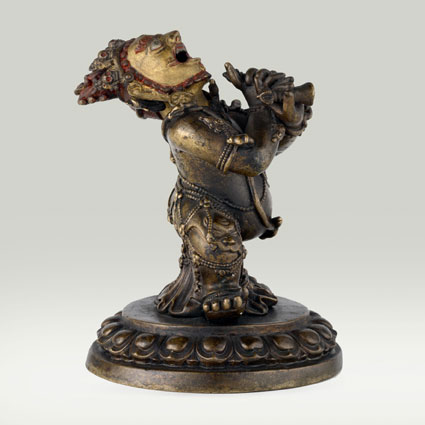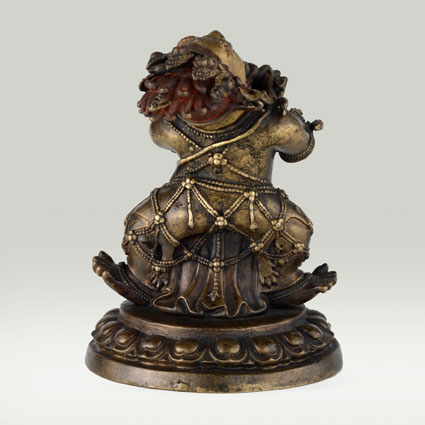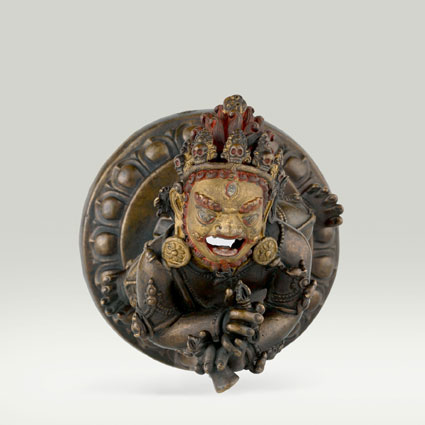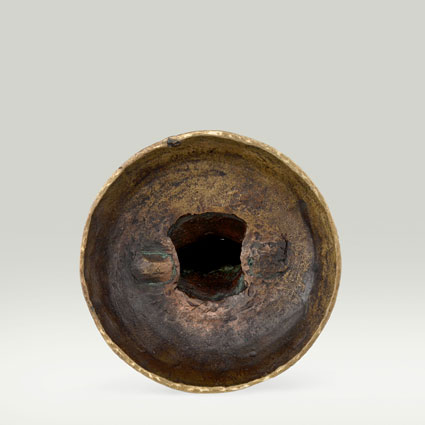Vajradaka
ABS 029
Code: ABS 029
Country: Tibet (central)
Style:
Date: 1550 - 1650
Dimensions in cm WxHxD: 9.1 x 11.7 x 9.1
Materials: Brass
Hollow cast in one piece.
The face is painted with cold gold and the hair, beard and eye brows are painted with a red pigment.
The pedestal is not sealed.
The Daka (Tib. lTo ’phye chen po) with wide open mouth is in a squatting position on a single circular lotus pedestal. The right hand holding a five-pronged diamond sceptre (vajra) and the left hand holding a prayer-bell (ghanta) are, with the hands turned outwards, crossed over of the chest in the “gesture of conquering the three worlds” (trailokyavijaya-mudra). He wears a five-fold skull crown, and there is a small effigy of Aksobhya on top of the flaming hair. The deity wears in addition to the apron the skin of a tiger (vyaghracarma) tied below the protruding belly with the face visible above the right knee. He is bedecked with jewellery and snake ornaments and wears the “investiture with the sacred thread” (nagopavita) in the shape of a snake.
The image is hollow worked in such a way that medicine can be administered by placing the image on the mouth of the patients.
The face is painted with cold gold and the hair, beard and eye brows are painted with a red pigment.
The pedestal is not sealed.
The Daka (Tib. lTo ’phye chen po) with wide open mouth is in a squatting position on a single circular lotus pedestal. The right hand holding a five-pronged diamond sceptre (vajra) and the left hand holding a prayer-bell (ghanta) are, with the hands turned outwards, crossed over of the chest in the “gesture of conquering the three worlds” (trailokyavijaya-mudra). He wears a five-fold skull crown, and there is a small effigy of Aksobhya on top of the flaming hair. The deity wears in addition to the apron the skin of a tiger (vyaghracarma) tied below the protruding belly with the face visible above the right knee. He is bedecked with jewellery and snake ornaments and wears the “investiture with the sacred thread” (nagopavita) in the shape of a snake.
The image is hollow worked in such a way that medicine can be administered by placing the image on the mouth of the patients.
The fire puja of Vajra Daka is a powerful practice to purify negativities of body, speech and mind. It is usually performed using black sesame seeds, which are considered to be a fitting symbol of one's own condition (black on the outside and white on the inside). This ritual is designed to help purify obscurations so that one may develop wholesome qualities.
Vajradaka (Tib. dor je kan dro)
A deity of purification from the Chakrasamvara Cycle of Tantras.
"...Vajradaka with a body blue-black in colour, one face. With the two hands at the heart performing the King of Desire mudra, the right holds a vajra and left a bell. Possessing three eyes, yellow hair flowing upward, a radiant face and adorned with bones, jewels and the eight great nagas. Wearing a lower garment of tiger skin, with the left leg extended..." (Chogyal Pagpa, 1235-1280).
This is a ritual piece used while performing one of several specific meditations involving purification. At a certain point in the meditation black sesame seeds are inserted into the mouth of the Vajradaka sculpture which then fall through the body and onto an incense pot filled with burning embers or coals. The seeds are burnt, and the smoke rises upwards and dissipates just as the defilements or sins of the practitioner are destroyed through the power of the ritual.
A deity of purification from the Chakrasamvara Cycle of Tantras.
"...Vajradaka with a body blue-black in colour, one face. With the two hands at the heart performing the King of Desire mudra, the right holds a vajra and left a bell. Possessing three eyes, yellow hair flowing upward, a radiant face and adorned with bones, jewels and the eight great nagas. Wearing a lower garment of tiger skin, with the left leg extended..." (Chogyal Pagpa, 1235-1280).
This is a ritual piece used while performing one of several specific meditations involving purification. At a certain point in the meditation black sesame seeds are inserted into the mouth of the Vajradaka sculpture which then fall through the body and onto an incense pot filled with burning embers or coals. The seeds are burnt, and the smoke rises upwards and dissipates just as the defilements or sins of the practitioner are destroyed through the power of the ritual.
Essen, Gerd-Wolfgang and Thingo, Tsering Tashi, 1990. Die Götter des Himalaya - Buddhistische Kunst Tibets. München: Prestel-Verlag. P. 210, no. II–440: Daka, Tokye Chenpo (Lto ’phye chen po) - Reference to iconography
Ribbach, Samuel H. , 1940. Drogpa Namgyal: Ein Tibeterleben Tibeterleben. München: Otto Willhelm Barth. P. 188 - Reference to iconography






